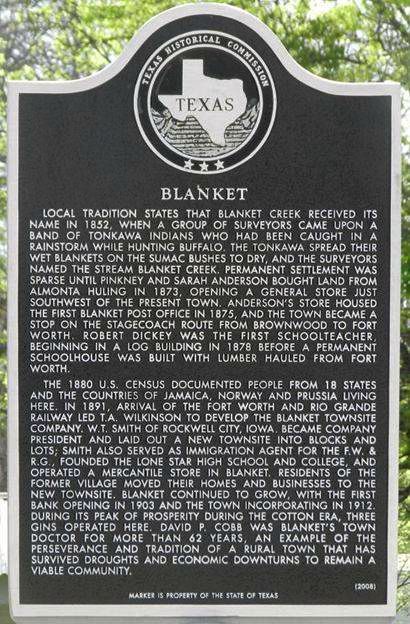|
Blanket Historical Marker
|
| Local tradition states that Blanket Creek received its name in 1852, when a group of surveyors came upon a band of Tonkawa Indians who had been caught in a rainstorm while hunting buffalo. The Tonkawa spread their wet blankets on the sumac bushes to dry, and the surveyors named the stream Blanket Creek. Permanent settlement was sparse until Pinkney and Sarah Anderson bought land from Almonta Huling in 1873, opening a general store just southwest of the present town. Andersonís store housed the first Blanket post office in 1875, and the town became a stop on the stagecoach route from Brownwood to Fort Worth. Robert Dickey was the first schoolteacher, beginning in a log building in 1878 before a permanent schoolhouse was built with lumber hauled from Fort Worth. The 1880 U.S. census documented people from 18 states and the countries of Jamaica, Norway and Prussia living here. In 1891, arrival of the Fort Worth and Rio Grande Railway led T.A. Wilkinson to develop the Blanket townsite company. W.T. Smith of Rockwell City, Iowa, became company president and laid out a new townsite into blocks and lots; Smith also served as immigration agent for the F.W. & R.G., founded the Lone Star High School and College, and operated a mercantile store in Blanket. Residents of the former village moved their homes and businesses to the new townsite. Blanket continued to grow, with the first bank opening in 1903 and the town incorporating in 1912. During its peak of prosperity during the cotton era, three gins operated here. David P. Cobb was Blanketís town doctor for more than 62 years, an example of the perseverance and tradition of a rural town that has survived droughts and economic downturns to remain a viable community. |
| Return to Historical Markers |
